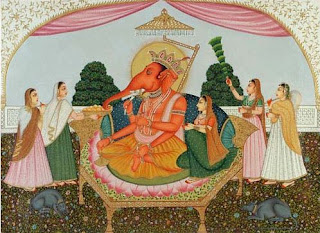In the upcoming Arunachala Grace Newsletter there is a narrative on the Screw-Pine focusing in particular on its ayurvedic and medicinal uses. The Newsletter will be sent out within some days, so if you are not yet a subscriber, please check out the 'facility' at the left hand margin of this page and receive the free monthly Newsletter direct to your email inbox.
Even though the Screw-Pine did in fact lie to Shiva, I've always felt a great sense of compassion towards it - 'It wasn't his fault, he got bad advice! Give him another chance!'.
To find out about the Column of Effulgence (i.e. Arunachala), Brahma and the lie, and also to learn more about the Screw-Pine, read on:
*******************************************************
Brahma:
“. . . saw a white streak approach him and as it came near, he saw that it was a flower of the screw-pine. Though faded, it was very fragrant and pure. Brahma took it in his hands, whereupon the flower spoke to him, “Ah! Why do you stop me? I have been travelling for many thousands of years and am tired. Please let me go.”
Brahma turned to the flower and asked:
“Who are you? Where are you coming from?” It replied, “I am a flower of the screw-pine. I am sentient. I dwelt on the crest of this column for a long time at Siva’s command. I am now coming down as I desire to see the world.”
Brahma asked the flower:
“How far away is the top of this Column of Effulgence?”
The flower of the screw-pine derisively smiled at Brahma and said:
“Who are you? You seem to know nothing. You cannot know the origin of this column. There are crores and crores of Brahmandas inside this column. They are countless. Who can measure its dimensions? I have been coming down for many thousands of four-fold yugas. Yet I have not perceived the earth which is its middle region.”
When Brahma heard this he abandoned his pride, clasped his hands, bowed to it and prayed:

The Column of Light“O great soul in the form of a flower of the screw-pine! I am Brahman, the Creator. There arose a dispute between Vishnu and myself. Both of us forgot the glory of Shiva. We became proud of our work, creating and sustaining the world. It is said that friendship arises even by exchanging seven words. You are a great soul. You must forgive my ignorance and be gracious to me. We began seeking the top and bottom of this Column of Effulgence in order to establish superiority over each other. Vishnu took the form of a boar and I, that of a swan. I am unaware of Vishnu’s fate. I who came to find the summit have flown for thousands of years and become weary. My life seems to be ebbing.
Friend! Fortunately I have met you. I am helpless. You are now my saviour. Pray, grant my wish. I beseech you. You must utter a life for me, your friend. Kindly avow in the presence of Vishnu that I have seen the summit of the Column of Effulgence and that you were witness to it since you (the flower) always decorates Siva’s head. Further, declare that I (Brahma) am superior to Vishnu.”
Implored thus, the screw-pine supported Brahma in his lie in the presence of the Column of Effulgence that the God had reached the summit. To punish them for this Shiva announced:
“Brahma . . . has uttered a falsehood, and I now cut off his fifth head for that perjury. Brahma shall not hereafter be installed in any Temple. And this screw-pine flower, which bore false witness, shall never again find a place on my head and shall not be used for my worship.”
[Abridged from The Glory of Arunachala]
*******************************************************
Screwpine
The Screw Pine is a shrub with fragrant flowers found wild in Southern India and grows in abundance along seacoasts and banks of rivers.
It is also known by the name of: Umbrella tree, Tamil: Thazhampoo and in Sanskrit: Ketaki. The shrub’s botanical name is Pandanus Odoratissimus of the Screw Pine family: Pandanaceae.
The Pandanus is also known as the Screw Pine due to the swirl of the leaves. It is one of the most useful plants in the tropics. Practically every part of the Screw Pine is used for all types of purposes: clothing, bowls, house building, food, medicine and fragrance.
It is only the male flowers of the tree that have a scent, which has been described as heavily fragrant, unforgettable and something similar to hyacinth-honey. The male flower of the Pandanus Odoratissimus can weigh two pounds or more and is also known as one of the five arrows of Kaman (the Indian Cupid).
 Male Flower
Male FlowerA mature flower with opening petals. But, the flower is at its best as a bud.
 Unripe Fruit
Unripe Fruit Ripe Fruit
Ripe Fruit


















































